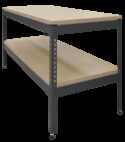Experiment
STS18

Frame Deflections and Reactions (Next Generation Structures)
Experiment for the study of rectangular portals subjected to vertical loads. Mounts on the Structures platform and connects to Structures automatic data acquisition unit and software.
If you have any questions or you'd like to discuss a product, please call us.
+44 1159 722 611Frame Deflections and Reactions (Next Generation Structures)
One of a range of experiment modules that fit to the Structures platform (STS1, available separately), this product helps students understand the deflections and reactions of a portal frame under various loading conditions.
Students fit one of a choice of two frames between two supports and apply vertical loads to the beam member. Load cells in the supports measure the bending moment and horizontal reaction at the base of the uprights due to the load. A precision indicator measures any horizontal deflection (sway) at the junction of the beam and the upright. Each support includes pointers that work with the scale on the platform for accurate positioning.
One of the frames has a uniform second moment of area for both the uprights and the beam, the other has one upright with a second moment of area of approximately half that of the other upright and the beam. Both frame beams can be loaded anywhere along their length. This allows the students to understand the two causes of frame sway other than direct loads.
Students apply loads to the portal frame. They use textbook equations and analysis to predict the reaction forces and fixing moments due to the load and whether or not the frame will sway and its magnitude. They compare predictions to measured and observed results. This helps confi rm the reliability of the textbook equations and the accuracy of the experiment results.
This product includes a Vernier caliper for accurate measurement of the frame cross-section.
The deflection indicator has its own display but it can connect (with the load cells) to the USB interface hub of the Structures platform for computer display and data acquisition.
Learning outcomes
• Horizontal reaction and fixing moment due to a varying single point load on a portal frame
• Uniform and non-uniform cross-section portal frames
• Predicting sway direction by consideration of shear forces
• Use of the moment distribution (Hardy Cross) method to calculate bending moments, sway magnitude and horizontal support reactions • Deflection (sway) of a portal frame due to loading asymmetry
• Deflection (sway) of a portal frame due to asymmetry of the uprights
• Plotting bending moment diagrams










